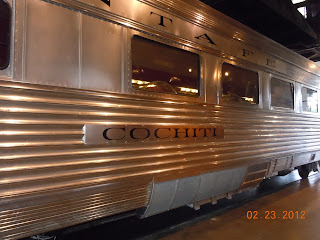The route of the Santa Fe Railroad Super Chief was essentially what today's route is for Amtrak's Southwest Chief. When the Super Chief began service in 1937 the schedule called for one run each week. When the Super Chief's popularity grew to it's highest, the train was scheduled once daily in each direction.
 |
| Super Chief in Albuquerque, NM |
The same route featured the AT & SF "El Capitan". This named train was a non-Pullman sleeper train whereas the first class Super Chief featured the Pullman sleepers. The El Capitan was an all coach train. During the era of these new streamlined diesel trains running through the southwest, the train ride itself was a culture adventure. In fact, the El Capitan was so named to honor the Spanish Conquistadors who had originally settled much of the southwest and California. You can see the cultural influence the AT & SF had on the southwest and that which the southwest had on the Santa Fe Railroad Super Chief when you have the opportunity to view some of the artwork featuring this train with the scenic southwest backgrounds. In the year 1958, the Super Chief and the El Capitan were combined as one train and this configuration stayed in place until the end of AT & SF's passenger service in 1971.
No doubt, the Super Chief had a strong marketing arm behind it. A very interesting book, All Aboard for Santa Fe; Railway Promotion of the Southwest , 1890's to 1930's, by author Victoria E. Dye,describes quite a lot about the marketing efforts of the Atchison Topeka and Santa Fe Railroad all the way back to the early years with Fred Harvey. Dye explains how the railroad gained passengers by promoting the unique culture of the southwest region with artwork and photographs in popular magazines and journals of the era.
The Atchison Topeka & Santa Fe Railroad may have been the best railroad as far as promotion went. Very early on, the railroad teamed up with Fred Harvey who would go on to establish the Fred Harvey Company with a large string of eateries and hotels along the AT & SF route. Harvey went on and managed the dining cars for the AT & SF when this service was introduced in 1892 with the railroad's "California Limited". When the Super Chief began service in 1937, the Fred Harvey Company managed the dining cars from the first day.
 |
| Super Chief lounge car interior |
For those wishing to see an authentic AT & SF Super Chief dining car, the California State Railroad Museum located in Old Town Sacramento, has one on display where you can also take a walk through it's interior. If your western trip happens to take you anywhere near Sacramento California, this is a great stop to make. All of the AT & SF Super Chief dining cars were named after Indian tribes or pueblos. The dining car on exhibit in Sacramento is named the "Cochiti" for the Native American pueblo just south of Santa Fe New Mexico. The California State Railroad Museum also displays a restored Super Chief diesel engine.
 |
| AT & SF Cochiti dining car |
Three additional related articles you will find interesting are Fred Harvey and the AT & SF Civilize the Southwest. The Historic La Posada Harvey House in Winslow Arizona and the old Harvey House dining room in Slaton Texas, now a B & B.
Today, the history minded tourist can learn a lot more about the famous Super Chief at the Galveston Railroad Museum in Galveston Texas which is set to open in November 2012. There will be a restored Super Chief engine on display there as well as other AT & SF rail cars.
(Albuquerque and lounge car interior photos from the public domain. Cochiti dining car photo from author's collection)

